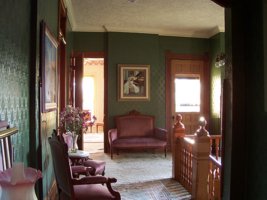In our website, there is a lovely description of the emotional value of oil portraits. Included on this page is a story about purchasing a family portrait as an anniversary gift for a couple after the narrator experienced difficulty figuring out what to buy. The part of the story that stood out most was when the narrator identified where the painting had been hung. First, it was hung during the anniversary party in “a place of honor” in the dance hall. Then, the woman arranged for it to be hung on her dining room wall. She looks at and appreciates it often there, and it both represents and reminds her of the joy of her family life.
I thought that both of those choices for portrait placement were very good. To have a quality portrait that is not placed in a place of honor – where it can be a focal point for visitors’ attention – is a sad thing. The wall space should not be too cramped, so this is important to think about before designating the size of the portrait. Furniture placement should be conducive to viewing the portrait, and the decorative intent of the room as a whole should be considered. Theme, style, and colors are elements to reflect on when selecting clothing and background for the portrait, and these elements should also come to mind when selecting the frame (more about this in another post) and the placement in the room.
Achieving a sense of harmony and balance with the portrait’s immediate environment – be it a bedroom, study, foyer, living room, den or office environment – is key to your continued enjoyment of the portrait. Pet portraits are hot now in the interior design world and a portrait of, say, an equestrian riding his prize thoroughbred or a young couple with their new beagle puppy might be well suited for a billiard room. A maternity portrait, however, would probably not be.
While the portrait may be hung as a solitary feature in one section of the room, another popular approach in interior decorating is to make it part of a collection of images hung together. The most important thing to remember when choosing a location for an oil painting, however, is to  avoid heat, excessive light, and moisture. Both heat and moisture can cause the canvas and/or the wooden canvas stretcher to expand and contract, which in turn causes the oil paint to crack or flake away. Direct sunlight or commercial light that is too close (such as when mounted on the painting) can also damage the paint and produce unwanted heat. Diffuse lighting from a relatively distant source is best. The following standards may be helpful: winter 65-70° Fahrenheit with 40%-45% humidity, and summer 70-75° Fahrenheit with 45%-55% humidity.
avoid heat, excessive light, and moisture. Both heat and moisture can cause the canvas and/or the wooden canvas stretcher to expand and contract, which in turn causes the oil paint to crack or flake away. Direct sunlight or commercial light that is too close (such as when mounted on the painting) can also damage the paint and produce unwanted heat. Diffuse lighting from a relatively distant source is best. The following standards may be helpful: winter 65-70° Fahrenheit with 40%-45% humidity, and summer 70-75° Fahrenheit with 45%-55% humidity.
Finally, when placing the painting be sure to avoid touching it with unclean hands or bumping the paint surface. Grasp it on both sides, rather than at the top or on the hanging wire.
